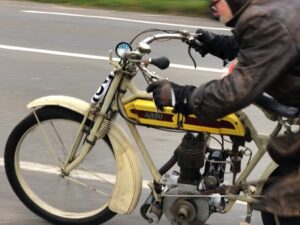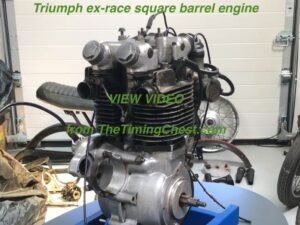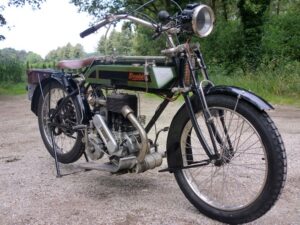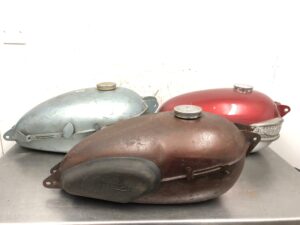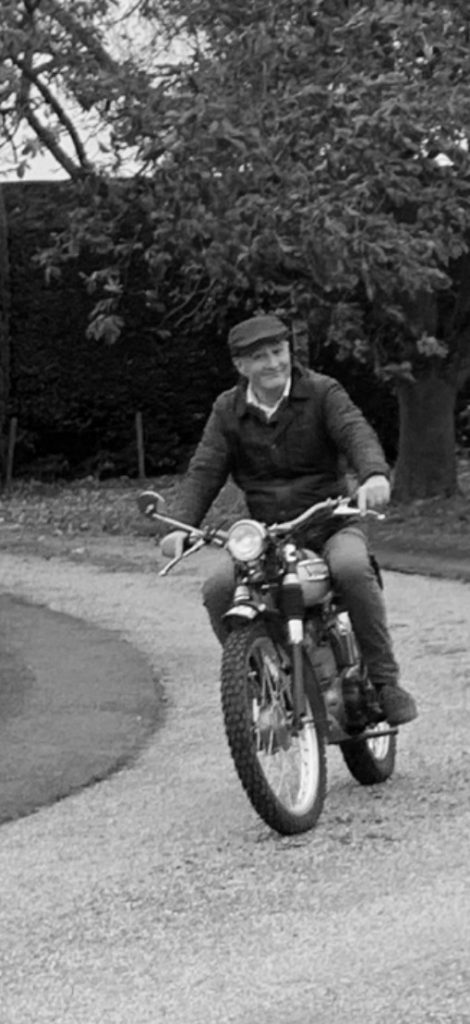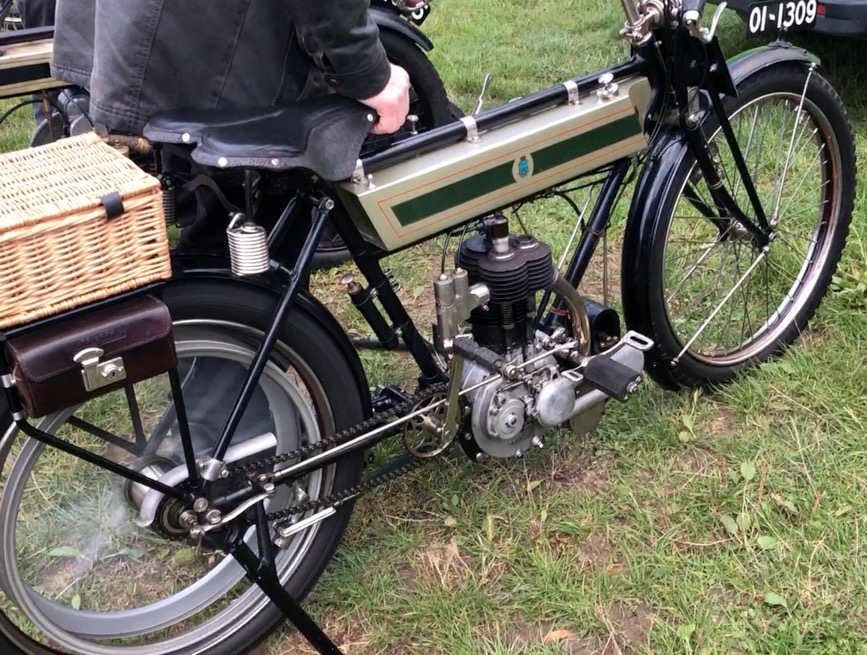
A guide to starting a veteran Triumph with a video of them warming up for the 2024 Pioneer Run.
Running a veteran motorcycle is a dark art. They are simple machines. However, after 110 years of use, they can be a little tired. Combine this with several changes of ownership where some owners didn’t take much care of these venerable beauties as much as we do, and you have a cocktail that makes each motorcycle unique. They may all be veteran Triumph motorcycles. But they are all different.
With this in mind, the following is a guide. It’s not a list of instructions.
To get you in the mood, I have prepared a short video of several veteran Triumph motorcycles that started the 2024 Pioneer Run. For those who are not familiar with the Pioneer Run, it is a ride of about 45 miles from just outside London, to the South coast of England. It’s organised by The Sunbeam Motorcycle Club and all motorcycles currently have to be dated as pre-1915. You will need to have the motorcycle certified by the Club. Read about the application process here.
See this video showing how varied these veteran Triumph motorbikes are. They vary in date from 1909 to 1914. Triumph went through a rapid phase of development in those years. For example, note the carburettors. They are all Triumph carbs, but they vary in detail.
Running and starting a veteran Triumph
Basic preparation
Walk around. Take a walk around the motorcycle and spend some time checking for any loose items or nuts. Then use an oiler to put a few drops of engine oil on each pivot link for the brakes. Add a little oil to the brake and clutch levers, the pedal spindle and anywhere else that moves regularly.
Take time to have a good look at the tyres. As we don’t use these machines very much, we can forget that we have had the same tyres on there for 10-15 years. The sidewalls will perish over time. Check for splits too. Tyres are generally inflated to about 35 psi on the front and 40 psi on the rear.
Magneto. While you have your oiler, go to the magneto. There is a rectangular lubrication cup over each magneto bearing. They have “flip-caps”. Open the cap and add enough oil to fill the cup.
Wheel bearings. Unless your machine has been altered, there is no need to lubricate the front hub bearings. They should be sealed.
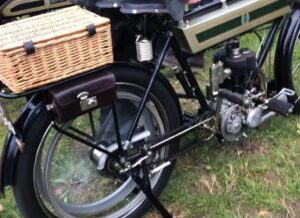
Veteran Triumph motorcycle rear hub with clutch
The rear wheel is a more complicated affair on the veteran Triumph. The rear hub includes a multi-plate clutch. Oil needs to be inserted into the hub. This lubricates the wheel bearings and the clutch. Most people use SAE 140. This isn’t a job that needs to be done every time that you ride. Just add the equivalent of a teaspoon full at a time. You probably only need to do this every few weeks if you ride regularly.
Engine. Everyone has their own perspective on which type of oil is best for their engine. I will make the point that multigrade oil isn’t great for these engines as it has a detergent additive. This can loosen the embedded dirt particles already in the engine. In turn, they can cause more wear. Plain old SAE 40 engine oil seems to be the favourite.
To add oil (if required) simply unscrew the oil cap on the front-left side of the petrol / oil tank and add oil to fill the reservoir.
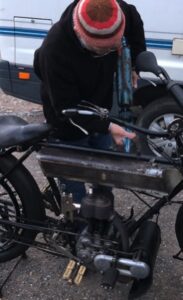
Veteran Triumph being fuelled up ready for the 2024 Pioneer Run
Fuel. After you have filled the oil reservoir in the tank, check the petrol level and fill as required. There’s much talk of leaded v’s unleaded petrol. in 1909, they didn’t have leaded petrol, so unleaded is fine. However, with the advent of petrol fillers, E5 is probably better than E10. If you can get unleaded 98 octane, that’s even better. The filler won’t do any harm to the engine, but it does cause issues with the flow of fuel through the filter, tap and carb jets if you leave the bike standing for a few weeks with fuel in the system.
These tanks hold about 1.5 gallons. They are good for about 100 miles. But it always makes sense to take a small spare tank of fuel on the rack.
Filling these tanks require a bit of patience. The filler hole in the tank is too small for a more modern fuel filler nozzle. Take a small funnel with you. There is no reserve in the tank. You have to keep an eye on the fuel sight gauge on the left side of the tank. It has a needle valve which is operated by a knob on the top of the tank. Unscrew the knob to allow fuel to enter the sight tube. This gives you some idea of the level of petrol in the tank. Make sure you close the needle valve after use.
Final checks.
Check the brakes work! They never worked very well. Get the best out of them. If you haven’t used your veteran Triumph for a while, the inside of the dummy belt rim might have a little bit of corrosion. Give it a quick clean with a wire brush. If you have used it recently, it’s probably slightly oily. Clean the inside of the rim and the brake block with something like brake cleaner (or a spray can of carburettor cleaner). This will remove the excess oil mist from that came from the engine.
Check the drive belt for condition and tension. If it’s too loose, remove a link. Or you could adjust the outer pulley sheave inwards. Be careful with this method of adjustment though. It alters your ability to climb hills as the final drive ratio is affected. It’s also quite a complex operation and probably best not described here. Try to remove a link from the belt first.
Priming your vintage Triumph motorcycle for the start
Now that you have topped everything up, checked for wear etc, it’s time to start it. There are some standard set-up procedures. These are a guide. Every machine behaves differently. Use this is a guide and make small adjustments to things like the advance lever position so that they suit your machine.
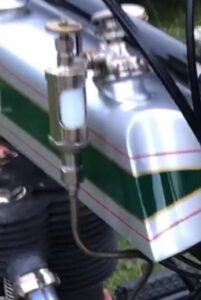
Veteran Triumph oil pump located on the right side of the petrol tank
Oil pump. The oil pump is located on the fuel tank. It’s on the right, near the front. Rotate the oil pump knob so that the raised spline of the pump shaft is inline with the slot in the gland nut. You can then pull the pump know up as far as it will go. This primes the oil. If you cannot push the knob down, it means the oil is primed.
Open the oil tap. This is also at the front of the tank, on the right side. Now push the pump knob down as far as it will go and close the tap. You have now added sufficient oil for about 8-10 miles. In about 8 miles, go through the process again. You should be able to do this while riding. You will see that some veteran bikes carry a spare can of oil. It’s a wise precaution. You don’t want to run out of engine oil.
Before a start, I suggest a couple of pumps of oil if starting from cold and if the bike has been unused for a while.
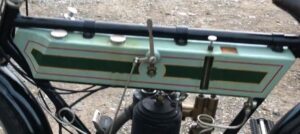
Veteran Triumph motorcycle petrol tank control advance and retard lever
Ignition. The ignition advance / retard lever is on top of the tank. Set the lever to the rear-most position (full advanced) and then move it about 3 clicks forward.
Fuel. Open the petrol tap. The lever should point to the ground. Priming the fuel involves lifting the thin spindle that is located on top of the float chamber. (more modern classics have a “tickler). Lift this spindle until it floods with fuel. Let go of the spindle.
Next, go to the priming tap which is on top of the engine cylinder. There is a priming spout on the underside of the fuel tank. Move the priming spout so that it is just above the priming cup and open the valve in the bottom of the fuel tank. Petrol should come out of the spout and go into the priming cup and then into the cylinder. Close the tap when you have dribbled a bit of fuel in and reverse the whole procedure. Once you have moved the spout clear, you are now ready to start the engine.
Starting the engine.
Everyone has their favourite way to get these motorcycles to start. Some people even use a roller-starter. I have even seen two bikes backed up to each other and on their stands. One bike is started and run at speed while the other one is coaxed into life by having the rear wheel turned by the running motorcycle’s rear tyre.
I have also seen the cool people simply pull the rear wheel to rotate it, while the motorcycle is on the rear stand.
I am going to suggest three methods.
Method 1. The simplest method. It involves a bit of exercise if your magneto isn’t producing an especially healthy spark. You set everything as shown above then raise the decompression lever. Engage the clutch. Run with the motorcycle and when you feel that you might have enough momentum, you lower the decompression lever and get ready to jump on the motorcycle if it fires up.
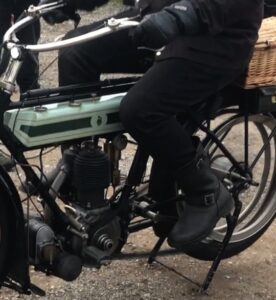 Method 2. If you have pedals, you can use these to turn the engine over while travelling down the road. It involves the same method regarding the decompressor lever and engaging the clutch. Raise the decompressor lever to pedal and then lower the lever when you have enough momentum with the crank. This is best with the assistance of a slope.
Method 2. If you have pedals, you can use these to turn the engine over while travelling down the road. It involves the same method regarding the decompressor lever and engaging the clutch. Raise the decompressor lever to pedal and then lower the lever when you have enough momentum with the crank. This is best with the assistance of a slope.
Method 3. Sit on your veteran Triumph while it is still on the stand and with the clutch dis-engaged. Look at your handlebars and then look at the throttle and air levers over on the right side. (Long = throttle). You have to balance these to keep the engine running. Set the air lever (short one). The way that it is suggested that you do this involves holding the handlebar grip as if you are riding. Then move the air lever with your left hand (the first time that you do this) so that the lever tip points to the point where your index finger meets your thumb. (I mean the joint between them). Then, set the throttle lever slightly to the left of the air lever.
Once you have the throttle and air levers set, you can raise the decompressor lever on the left of the handlebar) and begin pedalling.
When you have enough momentum, gradually open the throttle lever and the engine should fire up.
Pull the advance / retard lever all the way towards you and use the throttle to keep the engine running. When you feel that the engine is running well, you can dismount and apply the footbrake to stop the rear wheel from spinning.
That’s it.
As I mentioned earlier, this is a guide to starting a veteran Triumph. It’s meant for novices and the idea is to inspire more people to take an interest in owning and operating these interesting machines.
If you have a veteran Triumph, or a Pioneer-eligible motorcycle, you might like to look though my current selection of parts available. There won’t be much. That’s because it all sells very quickly. If you don’t see what you need, contact me with your needs.
